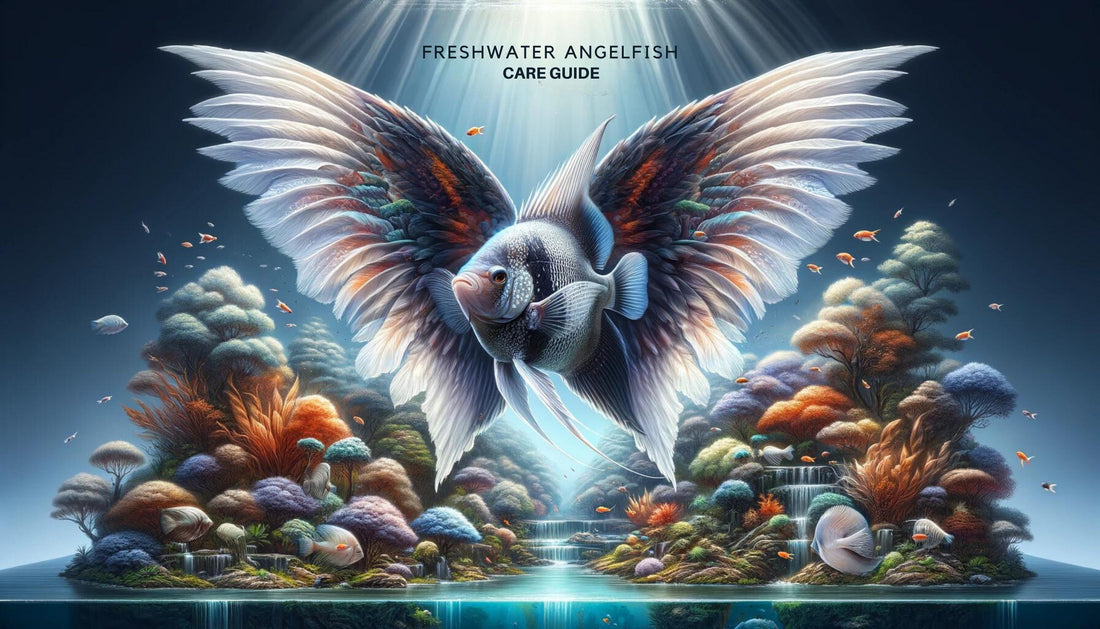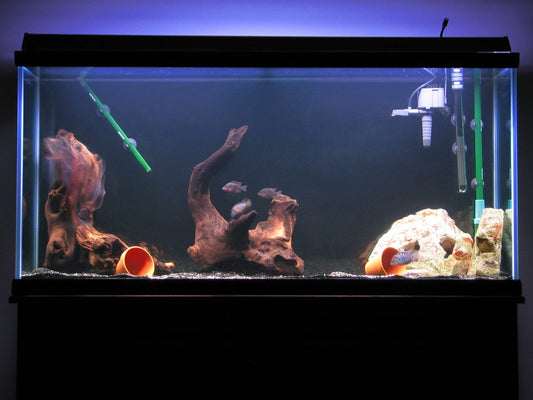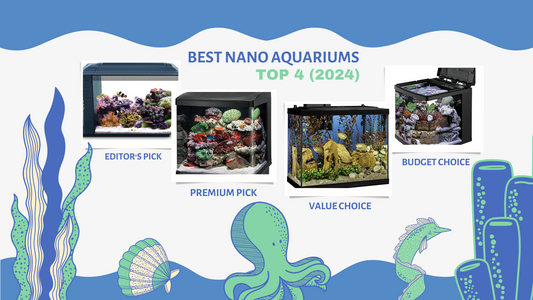Freshwater Angelfish Care Guide (2024)

🐠 Got an angelfish that's more high-maintenance than a celebrity on a juice cleanse? 🌟
You’re not alone. Freshwater angelfish are stunning, but boy, do they have specific needs!
Imagine this: You're testing your aquarium water for the umpteenth time (thanks, trusty aquarium water test kit!), adjusting the tank temperature yet again, and Googling "why is my angelfish looking at me funny?" It's like they know when the water isn't just right or if their tank mates are secretly plotting in the corner.
And let's not get started on those bare tanks that look more like a fish jail than a home. 🚔
Fear not, finned friend aficionados!
Here's a sneak peek of our fishy features:
- Perfect Water Paradise: Learn how to use that aquarium water test kit like a pro and keep those water conditions ideal.
- Fancy Fins and Friends: Tips on preventing fin rot and choosing the best community fish buddies.
- Tank Aesthetics 101: Transform bare tanks into lush, planted havens where your angelfish can strut their stuff.
- Temperature Triumphs: Keep that tank temperature steady and your angelfish happy.
Ready to make your angelfish the envy of the tank?
Freshwater Angelfish Care Sheet
- Scientific Name: Pterophyllum scalare
- Adult Size: 6 inches
- Temperament: Peaceful; Schooling
- Lifespan: 10-12 Years
- Care Level: Beginner
- Water Temperature: 76-84℉
- Appearance: Round and Compressed, with Silver, Black, and/or Gold tones
- Water pH: 5.0-7.0
- Diet: Carnivorous
- Tank Size: 30+ Gallons

Angelfish Overview
Typical Freshwater Angelfish Behavior
Angelfish are true cichlids and therefore closely related to some of the most aggressive fish in the aquarium hobby! Despite this, they are some of the most peaceful and relaxed of the family, making them a good choice for many freshwater aquariums. They won't dig up the substrate or tear plants apart like other cichlids tend to and they will ignore the majority of their tank mates.
NOTE: Angelfish are also very tolerant of each other and actually prefer being kept in small groups of 6 to 12 other fish. A lone freshwater Angelfish will still do well but they are fairly sociable if given enough space!
Angelfish Appearance
Angelfish have a graceful, elongated appearance that makes it obvious to see how they get their name. Even wild-type Angelfish have long, trailing dorsal and anal fins. Their tall fins and compressed shape evolved in order to help them weave in and among the weedy in the Amazon. Coupled with their silver base and black stripes they effortlessly blend in among the shadows and lights of the shallows to remain hidden from predators.
There are many captive bred varieties of Angelfish now that have diverse appearances. Selective breeding has led to some having even longer fins than their wild angelfish relatives (Veil Angelfish).
Others come in shades of grey, marbled patterns, pure silver, albino, and even a yellow-gold color. Among the different variations, there are koi angelfish, silver angelfish, albino angelfish, altum angelfish, and marble angelfish. Depending on the local fish store you go to, you can find plenty of these different colorful fish across the aquarium trade.
Life Span
Angelfish are fairly long lived freshwater fish. When well cared for, you can expect them to thrive for 10 to 12 years, with rare specimens living up to 15 years of age in a freshwater aquarium! In my tank, I currently have two koi angelfish which have been living together for over five years.
How Big Do Angelfish Grow?
5 to 6 inches in length is normal for an adult Angelfish. They will occasionally grow an inch or two beyond this but that is rare. Angelfish tend to be taller than they are long and can grow 8 to 12 inches in height. So aquascape accordingly, especially if you are keeping a group of other angelfish together.
Sexing Angelfish
Unfortunately, sexing Angelfish is nearly impossible (especially compared to other aquarium fish); both the males and females are next to identical in appearance. The fish likely tell through behavioral and hormonal releases. But we have just a single clue: the shape of their breeding organs.
Angelfish males have a pointed breeding tube that's almost always visible at maturity and extends even further when well fed. Females have a more rounded shape to their breeding organ and it can also extend outwards if full of food or eggs.

Compatible Tank Mates for Angelfish
Angelfish are one of the most mild mannered cichlids in the hobby and are excellent community tank companions for most medium to large fish. They are peaceful fish but can still be opportunistic predators. Therefore you should not keep adult koi Angelfish with smaller fish that can be swallowed, including Neon Tetras or Guppies. While some silver angelfish have been known to live with small fish, they don't typically make for suitable tank mates.
However, the majority of peaceful to semi-aggressive community fish are a good match for these hardy fish. Gouramis, larger Danios, Killifish, Swordtails, and Barbs are just a few choices. You can also keep them with other peaceful cichlids, including Severums (Heros efasciatus) and Kribs (Pelvicachromis pulcher).
Other Angel Fish are also great choices for companions. They may occasionally squabble or chase each other but they don't have the personalities or teeth to do any lasting harm. Angelfish tend to group in loose schools and glide through plants together.
Good Tank Mates for Angelfish Include:
- Mollies, Barbs, Gouramis, and other medium-sized Community Fish
- Severums, Kribensis, and other Peaceful Cichlids
- Other Angelfish
Water Conditions for Freshwater Angelfish
Get ready to enhance the safety and well-being of your freshwater or saltwater aquarium with Seachem Prime, the ultimate aquarium conditioner. Designed for both startup and routine water changes, Seachem Prime provides unparalleled protection for your aquatic environment.
Key Features:
- Removes Chlorine, Chloramine, and Toxic Ammonia: Seachem Prime is specially formulated to eliminate harmful chemicals from tap water, ensuring a safe habitat for your aquatic pets.
- Detoxifies Nitrite and Nitrate: By detoxifying these compounds, Prime enhances the efficiency of your aquarium's biofilter, improving overall water quality.
- Promotes Natural Slime Coat: Beyond just treating water, Prime encourages the development and regeneration of fish's natural slime coat, offering additional protection against diseases and stress.
- Easy to Use: With a straightforward dosing of 1 capful (5 ml) for every 200 L (50 gallons) of new water, it's simple to make your aquarium safe for its inhabitants.
Customer Review: "Since using Seachem Prime in my tank, I've noticed a significant improvement in the health and vibrancy of my fish. From angelfish to betta and even the most sensitive species, everyone seems happier. The water is clear, and the peace of mind knowing my fish are in a safe, stress-free environment is priceless. Prime is a game-changer for aquarium care!"
Temperature
While Angelfish are quite hardy they do have strong preferences when it comes to water conditions and temperature is one of the most important considerations. Angelfish are from the central Amazon region where water temperatures stay warm to hot year-round.
Coupled with their habit of staying in shallow portions of the river, they prefer temperatures ranging from 76℉ to as high as 84℉. 80℉ is a good compromise, with rises in temperature useful for promoting breeding behavior or helping them fight off an infectious disease. These warmer temperatures reflect the angelfish's natural habitat.
WARNING: Be cautious when adjusting temperatures, as sudden changes can adversely affect fish, leading to stress or health issues. Always monitor affected fish closely and make gradual adjustments to the water temperature.
Water Chemistry
As a member of the cichlid family, angelfish also prefer acidic to neutral water chemistry (pH 5.0-7.0). They have been captive bred for decades and will do fairly well even in alkaline conditions (pH 7.0+). But their disease resistance decreases and they are not going to spawn in alkaline water.
Angelfish come from streams and rivers full of decaying plant matter. These plant tannins decrease the pH and promote spawning behavior as well. Providing driftwood and Indian Almond Leaves can create a constant source of plant tannins, as can adding small amounts with each water change! Tannins will stain the water a dark color, but this effect is very appealing if you're interested in blackwater biotope aquariums!
Angelfish are a little more sensitive than other fish to high levels of ammonia and other nitrogenous waste products (nitrite and nitrate). So you should keep a test kit on hand to monitor these parameters if your Angelfish shows signs of stress. As long as you're keeping up with regular filter maintenance and water changes this should be a non-issue. I would not add Angelfish to a newly set up tank, however. It is much better to wait until a tank is fully cycled.
Tank Setup for Freshwater Angelfish
Dive into the enchanting world of aquascaping with the Aquatop Pisces Nano Cube Glass Aquarium. This elegant and compact aquarium brings the beauty of aquatic life right into your living space. Its high-clarity glass construction offers unimpeded views of your aquatic plants and the delicate features of your favorite fish, such as the graceful angelfish or the lively black skirt tetras.
The Nano Cube's design is not just about aesthetics; it's also about creating a healthy and thriving environment for a variety of aquatic life.
Feature:
- High-Clarity Glass for Perfect Viewing: Enjoy every detail of your aquatic inhabitants and plants through the crystal-clear glass of the Aquatop Pisces Nano Cube.
- Compact Yet Spacious Design: Though small in size, its thoughtful design offers ample space for a variety of fish and aquatic plants, making it an ideal habitat for a thriving mini ecosystem.
- Integrated Filtration and Lighting: Comes equipped with a powerful filtration system and LED lighting, ensuring your aquatic plants and fish are showcased in their best light while maintaining optimal water quality.
Customer Review: "The Aquatop Pisces Nano Cube has transformed my space! Its clear glass and compact size make it a perfect fit for my desk, and my fish have never seemed happier. The integrated filtration and LED lighting are excellent for keeping my plants healthy and my tank looking its best. Setting it up was straightforward, and it's become a focal point in my room. Absolutely the best addition to my aquascaping hobby."
Angelfish Tank Size
Tank size is another important consideration because Angelfish may start out small and cute but grow rapidly. In addition, because they are a semi schooling fish, they will need plenty of space to keep in a community aquarium. They reach sexual maturity by 8 months and will reach their full adult size in just a few years. Adult Angelfish are solidly in the medium sized category of aquarium fish and should be kept in tanks no smaller than 30 gallons.
And if you're interested in keeping a small group of Angelfish, you'll want at least a 40 breeder or better still, a 55 gallon tank for your shoal. This provides them with enough space to make occasional squabbles easy to resolve and enough water volume to handle their biological waste.
Live plants are also a great idea since these cichlids don't dig and feel comfortable when they can hide. Tall plants like Eelgrass (Vallisneria sp.) and Sagittaria are a natural match. Feel free to also include Amazon Sword Plants (Echinodorus sp.), which are naturally found alongside Angelfish in the wild. Their broad leaves also provide a ready spawning platform for mated Angelfish pairs!
Feeding Your Freshwater Angelfish
Hikari Sinking Cichlid Gold Medium Pellet Food, specifically crafted for the discerning cichlid, such as the majestic angelfish. These meticulously formulated pellets are designed to sink at a rate that compliments the natural feeding habits of angelfish, ensuring they can eat in a manner that's closest to their behaviors in the wild.
Rich in nutrients and fortified with color enhancers, Hikari Sinking Cichlid Gold pellets are the key to unlocking the vibrant potential in your angelfish, highlighting the shimmering silver of a P altum or the radiant gold of gold angelfish.
Features:
- Optimized for Cichlids: Tailor-made to meet the nutritional needs of cichlids, enhancing both their health and coloration.
- Ideal Sinking Rate: Designed to sink slowly, these pellets cater to the unique feeding style of angelfish, allowing them to feed naturally and comfortably.
- Nutrient-Rich Composition: Packed with a blend of high-quality proteins, including fish meal and necessary vitamins, mirroring the natural diet of angelfish with a balance of fresh ingredients.
Customer Review: "Switching to Hikari Sinking Cichlid Gold has made a noticeable difference in my aquarium. My angelfish are more vibrant and active than ever before. Even the ones that typically ignore pellets are now eagerly anticipating mealtime. Beyond the health and color improvements in my fish, I've also observed that the water remains cleaner for longer. This food is definitely a game-changer for any cichlid enthusiast!"
What Should I Feed My Angelfish?
Angelfish are true carnivores, feeding on small fish, worms, shrimp, and fallen insects in the wild. Therefore, we want to provide a protein-rich prepared food blend mixed with fresh and frozen foods in your own aquarium.
Cichlid pellets sized for their small mouths are your best bet. Be certain to read the nutritional label and choose blends with animal protein like salmon or shrimp meal as the first ingredient. Blends with wheat or soybean first won't have the protein that they need for proper health.
Any prepared food, no matter how complete, is no substitute for fresh and frozen food, though. So supplement their diet with thawed brine shrimp, bloodworms, tubifex worms, and other favorites of theirs! The extra fat and protein will also help condition your Angelfish to spawn by providing the nutrients they need for egg and sperm production! In addition to crushed flake food found in fish stores, baby brine shrimp can be fed to juvenile angelfish once they are born.
How Often Should I Feed My Freshwater Fish?
Angelfish are large, moderately active fish. Once they reach adulthood, two feedings per day is enough for them. When younger and actively growing, you should feed your Angelfish three times per day.

Breeding Your Freshwater Angelfish
How Can I Condition Angelfish to Spawn?
Conditioning Angelfish to spawn comes down mostly to providing them with clean, warm water and a diversity of prepared and fresh foods. Angelfish are very difficult to sex and can be picky when it comes to choosing a mate.
So I recommend raising a group of at least six young other Angelfish together and letting them pair off naturally in your freshwater aquarium. Even if a pair spawns they aren't so aggressive that they will kill the other fish in the tank. But they will be devoted parents, as are nearly all cichlids!
How Can I Tell if an Angelfish is Pregnant?
A female Angelfish that is carrying eggs will be visibly swollen since her sides are naturally very compressed. The ovipositor (breeding organ) will also be pushed outwards and much rounder in shape than that of a male Angelfish.
Once an Angelfish pair is close to spawning they will start hovering around a vertical hard surface as well. They prefer using the leaves of plants to lay their eggs on but they will also choose rocks, driftwood, or even the intake of a power filter if there's nothing else to use.
NOTE: breeding angelfish can be a rewarding experience, but one that calls for particular conditions and keen observation skills to detect signs of spawning and pregnancy.
Frequently Asked Questions
How Can I Sex Angelfish?
Angelfish males and females look nearly identical. If their breeding organs are visible, the male will have one with a slightly pointed shape while the female's is more rounded.
Are Angelfish Good Community Fish?
Angelfish will occasionally chase one another but they tend to ignore their tank mates. And even when spawning Angelfish are very mild tempered and are a good match for the majority of similarly sized community fish!
Are Angelfish Difficult to Care For?
Angelfish are a little sensitive to high levels of ammonia, nitrite, and nitrate. But as long as you are providing them with regular water changes and maintaining your filter you should have no issues. All in all, while maybe not the first fish to keep, freshwater angel fish make for great beginner fish!
How do I ensure the water is suitable for my angelfish?
Use an aquarium water test kit regularly to monitor water conditions. Maintaining the right tank temperature and clean water is crucial for keeping your beautiful fish healthy.
Can I keep angelfish with other types of fish?
Yes, angelfish can be kept with other community fish. However, be cautious with very small species, as they might be stressed by the angelfish's body shape and size.
Where is the best place to buy freshwater angelfish?
Look for reputable pet stores known for healthy, well-cared-for fish. Angelfish are a very popular fish, so you'll likely find them at most aquarium shops.
What are common health issues in freshwater angelfish?
Angelfish can suffer from fin rot and bacterial infections, especially in poor tank conditions. Look for signs like changes in the fish's body or vertical black stripes and consult a vet if needed.
Enjoying this article? Want more?
Join our Facebook community for more tips and shared experiences
>> "Aquariums For Beginners" Join Now <<

Conclusion
Keeping freshwater angelfish can be a rewarding experience. These beautiful fish, known for their distinct body shapes and elegant vertical black stripes, are a popular choice for aquarium enthusiasts.
Whether you're a seasoned aquarist or a newcomer, this guide should provide a comprehensive overview, answering questions from their dietary needs to compatibility with other fish, ensuring your angelfish live a healthy and happy life in your care.
No comments








comments